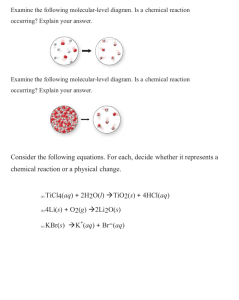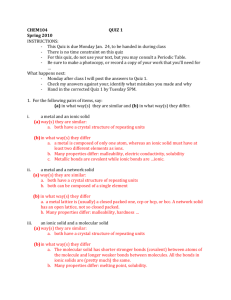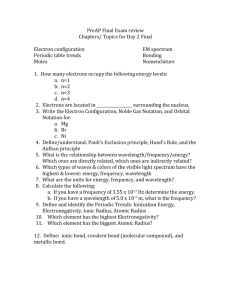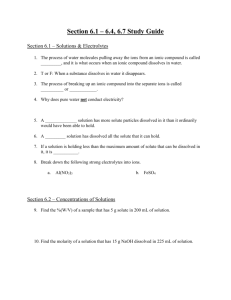Example: A Chemical Reaction
advertisement
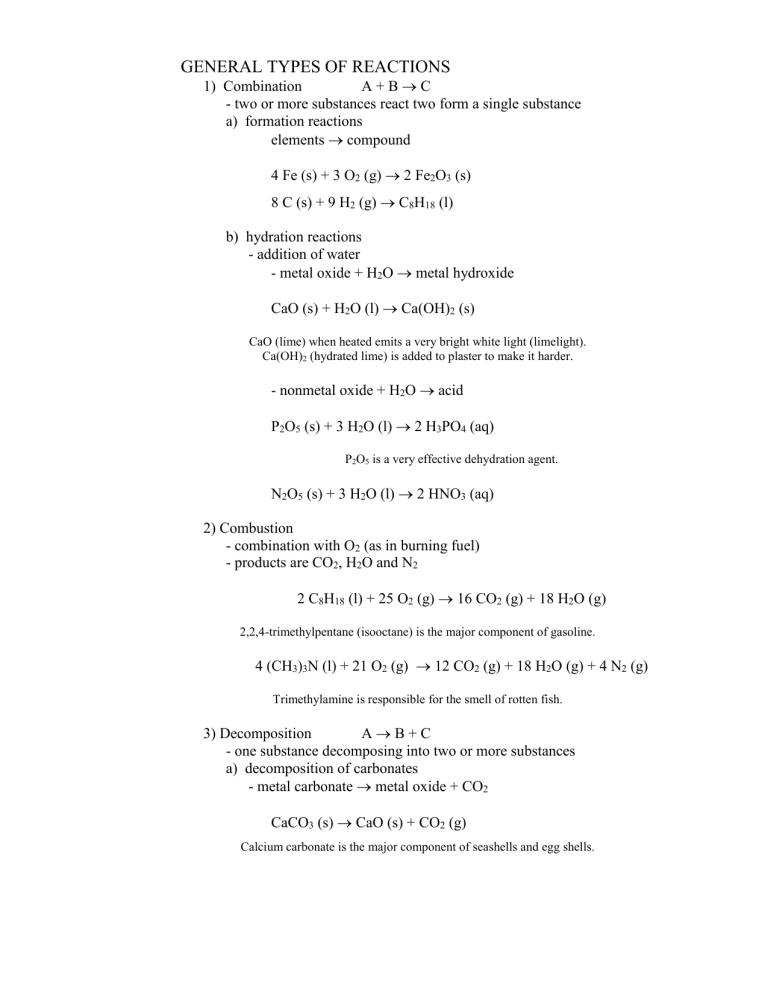
GENERAL TYPES OF REACTIONS 1) Combination A+BC - two or more substances react two form a single substance a) formation reactions elements compound 4 Fe (s) + 3 O2 (g) 2 Fe2O3 (s) 8 C (s) + 9 H2 (g) C8H18 (l) b) hydration reactions - addition of water - metal oxide + H2O metal hydroxide CaO (s) + H2O (l) Ca(OH)2 (s) CaO (lime) when heated emits a very bright white light (limelight). Ca(OH)2 (hydrated lime) is added to plaster to make it harder. - nonmetal oxide + H2O acid P2O5 (s) + 3 H2O (l) 2 H3PO4 (aq) P2O5 is a very effective dehydration agent. N2O5 (s) + 3 H2O (l) 2 HNO3 (aq) 2) Combustion - combination with O2 (as in burning fuel) - products are CO2, H2O and N2 2 C8H18 (l) + 25 O2 (g) 16 CO2 (g) + 18 H2O (g) 2,2,4-trimethylpentane (isooctane) is the major component of gasoline. 4 (CH3)3N (l) + 21 O2 (g) 12 CO2 (g) + 18 H2O (g) + 4 N2 (g) Trimethylamine is responsible for the smell of rotten fish. 3) Decomposition AB+C - one substance decomposing into two or more substances a) decomposition of carbonates - metal carbonate metal oxide + CO2 CaCO3 (s) CaO (s) + CO2 (g) Calcium carbonate is the major component of seashells and egg shells. b) decomposition of chlorates and perchlorates - metal chlorate metal chloride + O2 2 NaClO3 (s) 2 NaCl (s) + 3 O2 (g) - metal perchlorate metal chloride + O2 Fe(ClO4)3 (s) FeCl3 (s) + 6 O2 (g) Sodium chlorate is used in the manufacture of bleach (sodium hypochlorite, NaClO). c) decomposition of sulfites - metal sulfite metal oxide + SO2 Co2(SO3)3 (s) Co2O3 (s) + 3 SO2 (g) Sodium sulfite is added to wine to stop the fermentation process and to help preserve the wine. d) many others 4) Single replacement reactions - when a metal ion in a compound is replaced with another metal ion SnSO4 (aq) + Ni (s) NiSO4 (aq) + Sn (s) Tin bonds with iron very well and helps prevent the corrosion of iron. “Tin cans” are steel(iron) with thin covering of tin. 3 AgNO3 (aq) + Cr (s) Cr(NO3)3 (aq) + 3 Ag (s) Chromium is added to iron to make stainless steel. 5) Metathesis (double replacement) reactions - cations and anions in two ionic compounds switch places Na2SO4 (aq) + Ba(C2H3O2)2 (aq) BaSO4 (s) + 2 NaC2H3O2 (aq) Barium sulfate is ingested by X-ray patients to improve the visibility of GI tract to X-ray radiation. Pb(ClO3)2 (aq) + 2 KCl (aq) PbCl2 (s) + 2 KClO3 (aq) Lead(II) chloride combined with lead(II) hydroxide is used as a white paint pigment. 6) Addition - combination reaction where a substance is added to a compound with a double bond. H H H C C C H + H2O H H H H H H C C C H O H H H H H C H C H + HCl C H H H H H C C C C H Cl H H H H C H H H H C C + H2 H H H C C H H 7) Substitution - an atom or a functional group in molecule in substituted for another atom or functional group. H H H C H H O C C + H O H H H O H H H H C C C H H H O C C H H C C C C H C H C C H H H H H + OH- I Cl H + HNO3 H H + I- H H H H C C C H H H H C H O C C C C + H2O O C N H O H + HCl 8) Elimination - decomposition reaction where a double bond is created. H H H H C C O H H H H C C H H + H2O (when water is a product, the reaction is also known as a dehydration reaction.) H H H C C C H H H Br H H H H C C C C H H O H H H H C C C H O H C C H H C H H C H H C + H H C C H H C H H SOLUTIONS AND THEIR COMPONENTS Definitions solvent – bulk material used to dissolve substance solute – material dissolved in solvent Examples 1) salt water solvent – water solute – salt 2) dish water solvent – water solute – dish soap 3) engine coolant solvent – ethylene glycol solute – water + HBr H H H H O O H C C H H THE AQUEOUS PHASE Q: What happens to salt when it is dissolved in water? - It is a physical change, but how can that be? A: i) Solid salt is a collection of ions, Na+ and Cl-, assembled in a lattice. - Ions are surrounded by each other. ii) When dissolved, the ions are surrounded by water. - Thus, the ions themselves don’t change, only their environment. + - + - - + - + + - + - H H O H H O + O H H - + - O + H ion surrounded by other ions H ion surrounded by water molecules (solvent cage) Ions (or sometimes molecules) that are surrounded by water are in the aqueous phase. Ionic compounds which are soluble (that is, dissolve in water) dissociate (that is, break apart) into dissolved cations and anions. Examples: NaCl (aq) = Na+ (aq) + Cl- (aq) K2O (aq) = 2 K+ (aq) + O2- (aq) - note 2 K+ ions dissociate for every K2O unit. Ca(NO3)2 (aq) = Ca2+ (aq) + 2 NO3- (aq) - ions dissociate, but polyatomic ions remain covalently bonded. Fe2(SO4)3 (aq) = Cs3PO4 (aq) = *Not all compounds dissociate into ions when in the aqueous phase, as we shall soon see.* Aside: phases of reactants and products (g) – gas (l) – liquid (s) – solid (aq) – aqueous TYPES OF SOLUTES 1. electrolytes - when dissolved, solution conducts electricity - H2O without ions is a poor conductor. - are ionic compounds or acids (usually) a) strong electrolytes - Ions completely dissociate from formula unit or lattice. NaCl (aq) = Na+ (aq) + Cl- (aq) - Water surrounds ions to dissolve lattice. b) weak electrolytes - Ions partially dissociate from formula unit. HC2H3O2 (aq) + H+ (aq) + C2H3O2- (aq) a lot a little a little - Equilibrium (balance) exists between dissociated ions and undissociated compounds. More in 1190. HC2H3O2 (l) + H2O (l) 2.) nonelectrolytes - when dissolved, solution is still electrical insulator - usually molecular compounds C12H22O11 (s) + H2O (l) C12H22O11 (aq) Subtle point: Relatively insoluble compounds can be strong electrolytes. ACIDS, BASES AND SALTS Water (H2O) is made of two ions H+ (aq) – hydrogen ion OH- (aq) – hydroxide ion Acids – substances that increase H+ (aq) conc. Strong acids - strong electrolytes, i. e., completely dissociate HCl (aq) = H+ (aq) + Cl- (aq) - memorize list HCl, HBr, HI, HNO3, H2SO4, HClO3, HClO4 Weak acids - weak electrolytes HF (aq) ⇋ H+ (aq) + F- (aq) HF (aq) HF (aq) + H+ (aq) + F- (aq) a lot a little a little H3PO4 (aq) ⇋ H+ (aq) + H2PO4- (aq) Bases – substances that increase OH- concentration Strong bases - strong electrolytes - all alkali metal hydroxides LiOH, NaOH, KOH, RbOH, CsOH - some alkaline earth metal hydroxides Ca(OH)2, Sr(OH)2, Ba(OH)2 Weak bases - weak electrolytes - usually increase OH- (aq) conc. “indirectly” by decreasing H+ (aq) conc. NH3 (aq) + H2O (l) ⇋ NH4+ (aq) + OH- (aq) C5H5N (aq) + H2O (l) ⇋ C5H5NH+ (aq) + OH- (aq) Neutralization reaction Acid + Base Water + Salt Salt - ionic compound - cations and anions remaining after water is made HNO3 (aq) + KOH (aq) H2O (l) + KNO3 (aq) IONIC EQUATIONS - molecular equations where all ions in aqueous solution are written in dissociated form NET IONIC EQUATIONS - ionic equations where spectator ions (ions unchanged in reaction) are not included Example: Molecular Equation 2 KBr (aq) + Pb(NO3)2 (aq) 2 KNO3 (aq) + PbBr2 (s) Ionic Equation Net Ionic Equation Note removing spectator ions clarifies important part of reaction. Example: Molecular Equation HClO4 (aq) + NaOH (aq) H2O (l) + NaClO4 (aq) Ionic Equation Net Ionic Equation Example: Molecular Equation Fe (s) + CuSO4 (aq) FeSO4 (aq) + Cu (s) Ionic Equation Net Ionic Equation METATHESIS REACTIONS - Cations and anions in two ionic compounds switch places to form precipitate or nonionic compound. - Also known as double replacement reactions. - Compulsion of ions to combine to form other substances is called chemical driving force. - Three driving forces in metathesis reactions 1.) formation of a precipitate (solid) 2.) formation of a nonelectrolyte or weak electrolyte 3.) formation of gas CO2, SO2, H2S, H2 1. Formation of precipitate **To determine if precipitate is formed, solubility rules must be memorized.** Solubility Rules Generally Soluble Compounds Anion Exceptions NO3 , C2H3O2 None ClO3-, ClO4None - Cl , Br , I Ag+, Cu+, Pb2+, Hg22+ SO42Pb2+, Hg22+, Ca2+, Sr2+, Ba2+ Generally Insoluble Compounds Anion Exceptions 2S All alkali metals, NH4+, and Ca2+, Sr2+, Ba2+ 2-, 3CO3 PO4 All alkali metals, NH4+ CrO42-, C2O42All alkali metals, NH4+ 2OH , O All alkali metals and Ca2+, Sr2+, Ba2+ ** Note all alkali metal and ammonium compounds are soluble.** Using solubility rules to predict if reaction occurs - Reaction happens if precipitate is formed. - Reaction does not happen if precipitate is not formed. Example: Does the following reaction occur and what are its products? Na2S (aq) + Fe(NO3)2 (aq) To answer question, switch ions to form potential products. Na2S (aq) + Fe(NO3)2 (aq) NaNO3 ( ) + FeS ( ) Is NaNO3 or FeS insoluble? According solubility rules, FeS is insoluble. Therefore reaction occurs. Balanced molecular equation is Na2S (aq) + Fe(NO3)2 (aq) 2 NaNO3 (aq) + FeS (s) Ionic equation is Net ionic equation is Example: Does the following reaction occur and if so, what are its products? Cesium chloride (aq) + Calcium nitrate (aq) CsCl (aq) + Ca(NO3)2 (aq) CsNO3 ( ) + CaCl2 ( ) Is CsNO3 or CaCl2 insoluble? According solubility rules, both are soluble. No driving force is present; therefore, no reaction occurs. Balanced molecular equation is Ionic equation is Net ionic equation is Zip, zero, nothing, nada!!! - All the ions are spectator ions, no reaction occurs. Example: Does the following reaction occur and what are its products? Ammonium sulfate (aq) + Barium acetate (aq) (NH4)2SO4 (aq) + Ba(C2H3O2)2 (aq) NH4C2H3O2 ( ) + BaSO4 ( ) Is NH4C2H3O2 or BaSO4 insoluble? According solubility rules, all sulfates are soluble, except Ca2+, Sr2+ and Ba2+. Therefore reaction occurs. Balanced molecular equation is Ionic equation is Net ionic equation is 2. Formation of nonelectrolyte (weak electrolyte) Example Ba(OH)2 (aq) + 2 HI (aq) 2 H2O (l) + BaI2 (aq) Net ionic equation OH- (aq) + H+ (aq) H2O (l) - Formation of nonelectrolyte (water) is the driving force of the neutralization reaction. Example Hg2(C2H3O2)2 (aq) + 2 HNO3 (aq) 2 HC2H3O2 (aq) + Hg2(NO3)2 (aq) Hg2 2+ Ionic equation (aq) + 2 C2H3O2- (aq) + 2 H+ (aq) + 2 NO3- (aq) Hg22+ (aq) + 2 NO3- (aq) + 2 HC2H3O2 (aq) Net ionic equation C2H3O2- (aq) + H+ (aq) HC2H3O2 (aq) - Formation of weak electrolyte (acetic acid) is the driving force of the reaction. 3. Formation of gas - Common gases formed in metathesis reactions are CO2 (via H2CO3), SO2 (via H2SO3), H2S, H2. - Carbonic acid is unstable at high concentrations. H2CO3 (aq) H2O (l) + CO2 (g) - Sulfurous acid is unstable at high concentrations. H2SO3 (aq) H2O (l) + SO2 (g) - Addition of acid to all carbonates causes formation of CO2 via decomposition of carbonic acid. Example 2 HClO4 (aq) + MgCO3 (s) H2CO3 (aq) +Mg(ClO4)2 (aq) or considering decomposition of carbonic acid 2 HClO4 (aq) + MgCO3 (s) H2O (l) + CO2 (g) +Mg(ClO4)2 (aq) Example 2 HNO3 (aq) + CaS (aq) H2S (g) + Ca(NO3)2 (aq) Net ionic equation 2 H+ (aq) + S2- (aq) H2S (g) - reaction of sulfide with acid results in formation of hydrogen sulfide gas. SINGLE REPLACEMENT REACTIONS - also known as oxidation-reduction reactions - also known as redox reactions Definitions oxidation – process of substance losing ereduction – process of substance gaining eMnemonic: OIL RIG Oxidation Is Loss Reduction Is Gain *Oxidation and reduction must occur together.* - e- lost by substance must equal e- gained by other substance. Example 2 Na (s) + 2 HCl (aq) 2 NaCl (aq) + H2 (g) Net ionic equation 2 Na (s) + 2 H+ (aq) 2 Na+ (aq) + H2 (g) - Na is losing electrons, it is being oxidized - H+ is gaining electrons, it is being reduced Example Fe (s) + CuSO4 (aq) FeSO4 (aq) + Cu (s) Net ionic equation Fe (s) + Cu2+ (aq) Fe2+ (aq) + Cu (s) - Fe is oxidized - Cu2+ is reduced Predicting Spontaneous Redox Reactions - A redox (single replacement) reaction occurs when a metal ion in a compound is replaced with another metal ion. - Some metal atoms are more willing to give away electrons than other metal atoms. - The willingness of a metal atom to give away its electrons is called its activity. - In a reaction between metal ion (in aqueous phase) and metal, if metal is more active than metal ion, reaction will proceed. - We need to have an activity series to assess relative activity of metals. Abbreviated Activity Series Na Al Zn Cr Fe Ni Sn Pb H Cu Ag Au Increasing activity (willingness to be ionized) Example SnSO4 (aq) + Ni (s) NiSO4 (aq) + Sn (s) - Ni replaces Sn2+ - Ni is more active than Sn Does the reverse reaction occur? NiSO4 (aq) + Sn (s) SnSO4 (aq) + Ni (s) NO!! - Sn is not more active than Ni Example: Does the reaction, Pb(NO3)2 (aq) + Cu(s) Pb (s) + Cu(NO3)2 (aq) occur? Example: Does the reaction Fe2O3 (s) + 3 Zn (s) 2 Fe (s) + 3 ZnO (s) occur? - reactant metals are Fe2+ and Zn Because zinc is more active than iron, it is used to protect iron from rusting (galvanizing). Example: Does the reaction Al2(SO4)3 (aq) + 2 Cr (s) 2 Al (s) + Cr2(SO4)3 (aq) occur? REACTION TYPE REVIEW 1) Combination recognize - formation reactions: predict products, know reactants - hydration reactions: predict products 2) Combustion predict products, know reactants 3) Decomposition recognize - decomposition of carbonates: predict products - decomposition of sulfites: predict products - decomposition of chlorates, perchlorates: predict products 4) Single replacement reactions: predict products 5) Metathesis (double replacement) reactions: recognize - neutralization: predict products - precipitation: predict products - gas formation: predict products, H2, H2S, CO2, SO2 - recognize chemical driving forces - H2CO3 (aq) H2O (l) + CO2(g) - H2SO3 (aq) H2O (l) + SO2(g) 6) Addition: recognize 7) Substitution: recognize 8) Elimination: recognize SOLUTIONS Definitions solvent – bulk material used to dissolve substance solute – material dissolved in solvent Examples 1) salt water solvent – water solute – salt 2) dish water solvent – water solute – dish soap 3) engine coolant solvent – ethylene glycol solute – water Concentration - amount of solute per amount of solvent - molarity moles of solute mol Definition: Molarity M liters of solution L - molarity can be thought of a conversion factor between volume and # of moles. - we’ll consider other concentration units in 1190 Molarity calculations Example: What is the molarity of a solution of NaCl that has 1.73 molNaCl dissolved in 2.14 L of solution? Example: What is the molarity of a KBr solution when 114.8 g of KBr is dissolved in water to make 538.1 mL of solution? How many moles of solute are to be dissolved? - note the conversion of mL to L Example: How many grams of gold are in 3.75 L of 0.024 M solution of Au(NO3)3? We can convert between volume of solution and moles of solute using molarity as a conversion factor. DILUTIONS - making a solution of lower concentration from a solution of higher concentration Question: If a 5.0 M solution of NaCl is available, how does one make 250 mL of 2.0 M NaCl? 1) To make solution, we need to have the correct number of moles of NaCl. Md mold mold M d Vd Vd mold 2.0 mol 0.250 L 0.50 mol L 2) Now consider how to get 0.50 molNaCl from a 5.0 M solution. Mc Vc molc molc Vc Vc Mc 0.50 mol 0.10 L 5.0 mol L 3) Therefore, to make 250 mL of 2.0 M NaCl, one needs 100 mL of 5.0 M NaCl. Then add water to make 250 mL solution. Reconsider step 2. Where did # of mold come from? **Number of moles of solute is the same before and after dilution.** i. e., mold = molc Knowing mol = M V yields Md Vd = Mc Vc When generalized for any concentration unit, the result becomes the dilution equation cd Vd = cc Vc c – concentration Example: Find the volume of 6.02 M HCl to make 500 mL of 0.125 M HCl. Lab Safety Aside: Never add water to acid, always add acid to water. SOLUTION STOICHIOMETRY - Previously, we dealt with comparing components of a chemical reaction by converting mass of substances to moles. - Now we will consider solutions where we will need to convert volumes to moles to make comparisons. Scheme: Mass of reactant (g) Mass of product (g) M Molar mass M Molar mass Moles of reactant (mol) M Molarity Volume of reactant (L) Balanced equation Moles of product (mol) M Molarity Volume of product (L) GRAVIMETRIC ANALYSIS Measure the concentration of solution by measuring the mass of a precipitate formed. - Use grams of precipitate to find moles of solute. - Divide by volume of solution to find concentration. Example: 25.00 mL of Pb(NO3)2 solution with an unknown concentration reacts with excess aqueous Rb3AsO4. After filtering and drying, 0.0814 g of precipitate is found. What is the concentration of the lead(II) nitrate solution? M(Pb3(AsO4)2) = 692.2 g/mol 3 Pb(NO3)2 (aq) + 2 Rb3AsO4 (aq) Pb3(AsO4)2 (s) + 6 RbNO3 (aq) VOLUMETRIC ANALYSIS Measure the concentration of solution by measuring the volume of solution need to find stoichiometric equivalence between reactants using a titration. - Use volume of titrant to find moles of analyte. - Divide moles of analyte by volume of analyte to find concentration. - Acid/base reactions are commonly used but not always. Example: What is the concentration of a HBr solution when 50.00 mL is titrated with 41.88 mL of 0.1762 M KOH? KOH (aq) + HBr (aq) H2O (l) + KBr (aq) LIMITING REAGENT PROBLEMS Recall the following about limiting reagent problems. - To find limiting reactant, calculate number of moles of product formed from each number of moles of reactant. - Limiting reactant will yield lowest number of moles produced. Example: How many grams of Zn(OH)2 are produced when 350 mL of 0.152 M of ZnSO4 is mixed with 250 mL of 0.275 M of LiOH? First write balanced equation ZnSO4 (aq) + 2 LiOH (aq) Zn(OH)2 (s) + Li2SO4 (aq) Now calculate possible amount of product that each reactant can produce. Therefore, LiOH is the limiting reagent. Example: When 732 L of 1.81 M of Ag2SO4 is mixed with 1148 L of 2.07 M of KBr, a) kilograms of AgBr (s) formed b) concentration of all metal ions remaining a) Ag2SO4 (aq) + 2 KBr (aq) 2 AgBr (s) + K2SO4 (aq) KBr is the limiting reactant. In photographic film, AgBr decomposes on exposure to light which darkens the negative. 2 AgBr(s) + h 2 Ag(s) + Br2 (l) b) Find concentration of metal ions remaining. The metal ions we might have in solution are Ag+ and K+. i) Consider the concentration of K+ first. - K+ is a spectator ion. - It hasn’t participated in any chemical change. Number of moles of K+ ion is same as number of moles of KBr initially. Volume of solution is 732 L + 1148 L = 1880 L. Note that although KBr is limiting reagent, none of the K+ is used. This means that we could be more precise by saying that Br- is the limiting reagent. ii) Consider the concentration of Ag+. Once reaction is complete, most of the Ag+ ion is now part of AgBr solid. But since Ag+ ion is not limiting reagent some of it remains. How much remains? First of all how much Ag2SO4 went into AgBr solid. Therefore subtract Ag2SO4 used from Ag2SO4 total. total - used remaining 1325 mol -1188 mol 137 mol We need to be careful about dissociation of Ag2SO4. Thus concentration of Ag+ is


